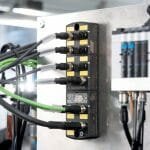The days of looking down the lens of a microscope are fast being eclipsed by super-resolution microscopy (SRM) that allows researchers to investigate and understand intracellular processes and interactions at a molecular level. Given the significant improvement in resolution achieved by SRM techniques, the ability to position samples and objectives accurately is obviously a key requirement to fully exploit the capabilities of these systems. Fortunately, piezo positioning systems – already considered the gold standard for the fine positioning of both sample stages and objectives in a broad range of microscopy techniques – offer the sub-nanometre accuracy required.Piezo actuators are currently used for three main applications in SRM: Z-positioning of objectives, manipulation of illumination systems (such as in light sheet and 4Pi techniques), and positioning of sample stages. Each of these applications obviously has unique requirements in terms of range of travel, reproducibility and settling times but, in general terms, system integrators want piezo-controlled movements to be as rapid, precise and stable as possible. For example, SRM can be used to produce rapid 3D scans of a complete cell or tissue sample. As metabolic processes continue throughout image acquisition, actuator speed directly influences the quality of experimental results – the faster a scan can be completed, the better it represents a ‘snapshot’ of a single time point.
Rapid and reproducible bidirectional positioning is also important when conducting time-lapse studies. It is essential that users can bookmark the position of cells or structures of interest, then quickly and consistently relocate those same structures for quantitative image analysis. Precise positioning and speed are essential, as processes in sub-cellular systems often run on short timescales, making the experiment time critical.
Products such as Physik Intrumente’s PIFOC® series have been in widespread use for over 20 years, and the latest generation piezo flexure actuators combine 0.5 nanometre precision with very long travel – up to nearly 500 micrometres in some cases – and rapid settling times of less than 20 milliseconds. Add to this the fact that the majority of these systems are more stable than motorised drives and virtually maintenance free, and it is clear why piezo actuators are the natural choice for laboratories developing SRM platforms.
The latest generation of SRM systems are achieving spatial resolutions of around 20 nanometres, and the sub-nanometre positioning precision offered by current piezo-based drives will help to increase this resolution even further. Despite this, microscope integrators have been demanding longer travel ranges, greater stiffness and higher speeds since the construction of the very first SRM systems, and the development of customised solutions to meet this growing demand will be vital as optical microscopy pushes further into the nanodimension.
To learn more about PI’s range of microscopy positioning systems, go to www.physikinstrumente.co.uk/en/applications-markets/microscopy





